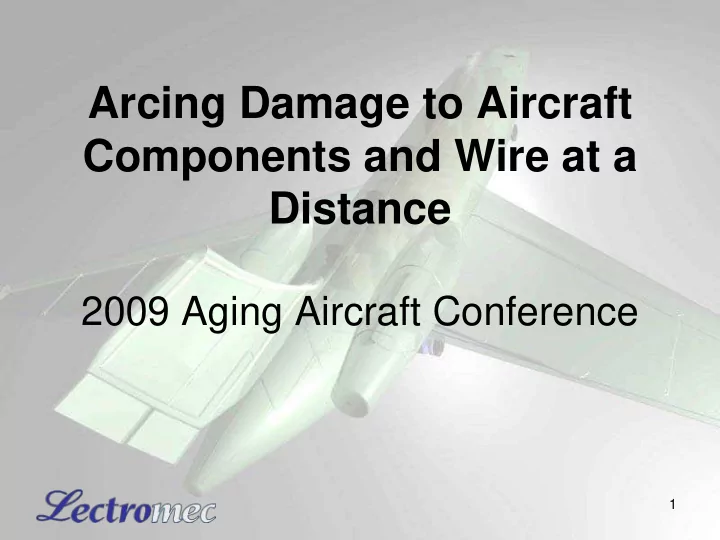

Arcing Damage to Aircraft Components and Wire at a Distance 2009 Aging Aircraft Conference 1
Why Examine Damage at a Distance? • The damage that can be caused by electrical arcing from wires has been well documented. • Items such as the chafing of a power wire against a grounded hydraulic line and the subsequent damage have previously been examined. • When an arc occurs, some of the energy is used to ionize and heat the local gas. This ‘arc plume’ can cause damage to targets an inch away from the arcing event. • Because this arc plume is ionized, this makes it possible for air to conduct electricity and therefore to arc directly from the power wire to a grounded target. 2
Why Examine Damage at a Distance? • Under normal circumstances, 115 volts is not able to jump a 0.01” gap. However, if arcing has been initiated by direct contact or a conductive media, the arc plume will allow a larger gap to be bridged. • The purpose of these tests is to show the potential electrical energy transfer and damage to targets at a defined distances from arcing wires. • Methods using both wet and dry initiation have been developed. 3
What Parameters Matter? • Of the many variables that can exist in an arcing event, four have the greatest impact – Separation Distance – Fault Current – Circuit Protection (Duration) – Wire Type (Gauge, Insulation material and Construction) 4
Damage at a Distance with Wet Initiation Method Grounded Hydraulic Tube Held Ground Wire at Fixed Distance from Wires Power Wire Fluid Delivery Breach in Power and Tube Ground Wire Insulation Middle Three wires Connected to 50 Ω Load 5
Damage at a Distance with Wet Initiation Method 6
Experiment • 250 Amp Fault Current, 115VAC • Polyimide Wire • 14AWG • 20Amp Thermal Circuit Breaker • Separation distance: 0.385” 7
Results of Experiment • Electrical Energy Transfer to Tube: • 743 Joules [Top Pic] Extensive damage to the tube. • [Bottom Pic] Damage to both active and passive wires (breach of passive wires) • Scale 1mm x 1mm. 8
Damage at a Distance with Dry Initiation Method Grounded Hydraulic Tube Held at Fixed Distance from Wires Ground Wire Breach in Power Wire Insulation Power Wire Grounded Wire Clamp affixed to end of Stick 9
Damage at a Distance with Dry Initiation Method 10
Experiment • 500 Amp Fault Current • Polyimide Wire • 14AWG • 15Amp Thermal Circuit Breaker • Separation distance: 0.5” 11
Results of Experiment Clamp Voltage and Current Measurements Arcing to the pipe started about 50ms after the arc Pipe Voltage and Current Measurements initiation. 12 R273-2
Results of Experiment (cont.) • Electrical Energy Transfer to Tube: 362 Joules • [Top Pic] Extensive damage to the tube (6mm x 6mm damage area). No tube penetration. • [Bottom Pic] Some damage to the passive wire, but no breach to conductor. • Scale 1mm x 1mm. 13
Experiment using TKT insulated wire • 500 Amp Fault Current • TKT Wire • 16AWG • 15Amp Thermal Circuit Breaker • Separation distance: 0.5” 14
Results of Experiment Clamp Voltage and Current Measurements Pipe Voltage and Current Measurements 15 R273-8
Results of Experiment (cont.) • Electrical Energy Transfer to Tube: 0.0 Joules • [Top Pic] Wide damage pattern will only minor scaring. • [Bottom Pic] Breach of top layer of Teflon, but no damage to other layers. • Scale 1mm x 1mm. 16
17
18
Conclusions • For Polyimide wire in which arcing has been initiated it is possible to have repeated ½ cycles of arcing across a 3/8” or ½” gap and transfer significant energy. • When the gap is increased to ¾” or 1” the likelihood of bridging the gap is reduced, normally arcing is non-continuous, and the current and energy transferred is reduced • For TKT wire arcing is sporadic limiting the arc plume therefore reducing the probability of direct arcing at a ½” and greater. 19
Lectromec History • Technology and Engineering firm – Specializing in aircraft wiring testing, wire management services, research and design. – Lectromec’s laboratory is equipped to test and analyze electrical systems of various types for a variety of industries. – Particular attention to Lectromec’s forté is understanding the electrical and physical properties of wiring insulation and the ill effects of damaged wiring. – Facilities include: A Wet / Dry Arc Track Station, Machine Shop, Chemistry Lab, Wire Storage Room, Accelerated Aging Test Apparatus, Polyimide Database, Hi-Pot Station, DelTest ™ Station, Humidity Chambers, a Technical Library and a Graphics / Art Station. 20
Questions? 21
Recommend
More recommend